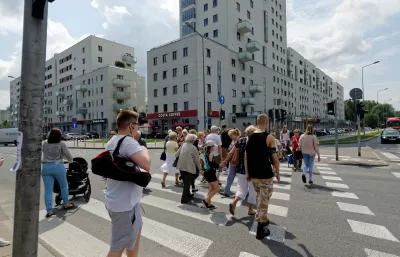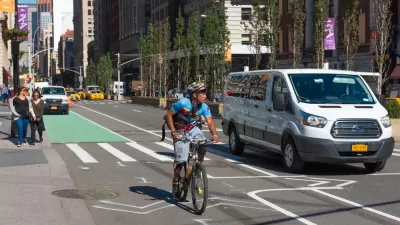The assumption that it’s “impossible” to live without a car in many American cities perpetuates infrastructure projects that privilege and induce driving.

In light of the many harmful effects of an overreliance on automobiles, “Why can’t we ask people to drive less and use transit or walk or bike?” asks Rachael Ludwick in The Urbanist. “Because, as implied in a recent New York Times article and claimed commonly elsewhere, it’s supposedly ‘infeasible’ in much of the United States to live without a car.”
This is largely because, Ludwick argues, “Our system has for more than eighty years subsidized driving in myriad ways that people don’t even notice.” Yet “People who can’t or don’t drive learn to get around wherever they live: and they live everywhere including places that are ‘impossible’ or ‘infeasible’ without a car.”
For Ludwick, walking is often a joyful experience. “But it’s not always a joy for everyone because many places do lack safe and convenient ways to walk, bike or bus. Our lives – and frankly everyone’s lives – could be immensely improved if only more people were driving less and were less committed to protecting driving and space for it.”
Ludwick also points out the environmental impact of driving. “In the United States, 29% of our carbon emissions come from transportation, mostly private vehicles,” calling on more people to try new transportation modes and pressure policymakers to fund safe walking and biking infrastructure and public transit. “Millions of Americans trying to get around without their cars will build support for the myriad of fixes we need to create a transportation system that works for everyone.”
FULL STORY: What If You Didn’t Have to Drive a Car?

Planetizen Federal Action Tracker
A weekly monitor of how Trump’s orders and actions are impacting planners and planning in America.

San Francisco's School District Spent $105M To Build Affordable Housing for Teachers — And That's Just the Beginning
SFUSD joins a growing list of school districts using their land holdings to address housing affordability challenges faced by their own employees.

The Tiny, Adorable $7,000 Car Turning Japan Onto EVs
The single seat Mibot charges from a regular plug as quickly as an iPad, and is about half the price of an average EV.

Seattle's Plan for Adopting Driverless Cars
Equity, safety, accessibility and affordability are front of mind as the city prepares for robotaxis and other autonomous vehicles.

As Trump Phases Out FEMA, Is It Time to Flee the Floodplains?
With less federal funding available for disaster relief efforts, the need to relocate at-risk communities is more urgent than ever.

With Protected Lanes, 460% More People Commute by Bike
For those needing more ammo, more data proving what we already knew is here.
Urban Design for Planners 1: Software Tools
This six-course series explores essential urban design concepts using open source software and equips planners with the tools they need to participate fully in the urban design process.
Planning for Universal Design
Learn the tools for implementing Universal Design in planning regulations.
Smith Gee Studio
City of Charlotte
City of Camden Redevelopment Agency
City of Astoria
Transportation Research & Education Center (TREC) at Portland State University
US High Speed Rail Association
City of Camden Redevelopment Agency
Municipality of Princeton (NJ)





























